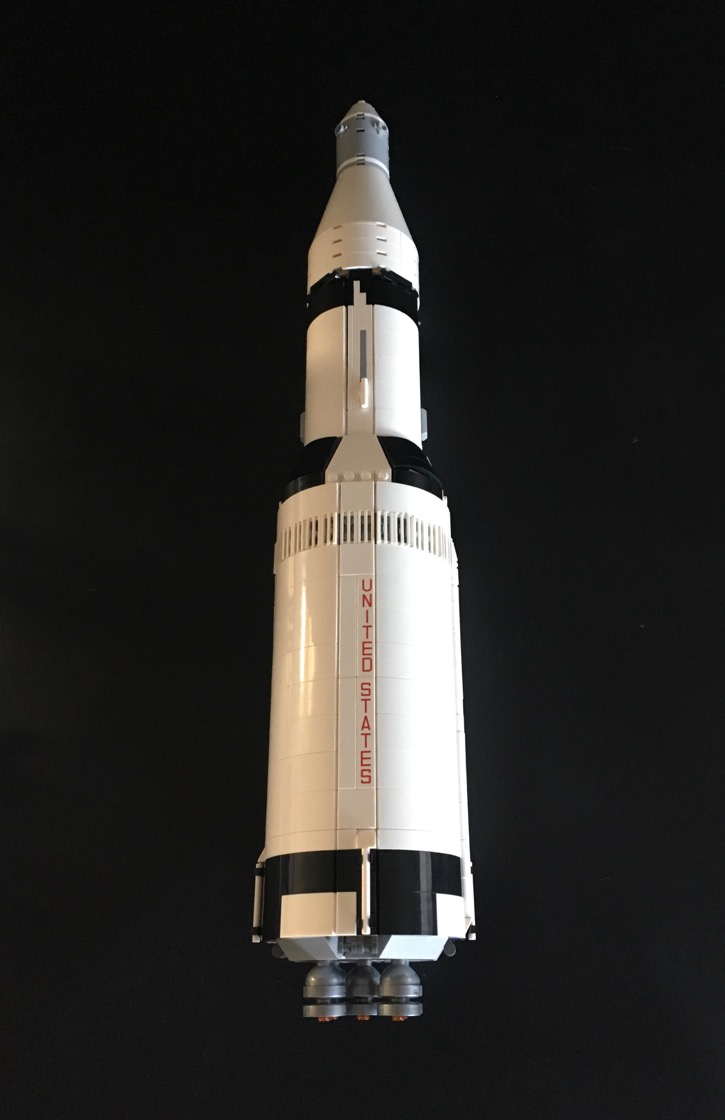With the work done, we set about having some fun with this thing!
The designers very thoughtfully included the makings for a support gantry allowing the completed rocket to be placed on its side.
T-Minus 5..... 4..... 3..... 2..... 1..... Lift-off!
Different sources provide different specific numbers, but the First Stage burns for about 2.5 minutes, carrying the craft to an altitude of about 40 miles. At this point, the First Stage and Launch Escape System are jettisoned and the Second Stage begins its roughly 6 minute burn to carry the craft to an altitude of about 109 miles. These guys are going FAST....
The Second Stage is jettisoned and the Third Stage burns for about 2 minutes, carrying the craft to a low orbit at around 118 miles altitude.
After a couple of orbital passes, the Third Stage is burned again for about 6 minutes, taking the craft out of Earth orbit and on its way to the moon. When this burn is complete, the Service and Control Modules separate from the Third Stage and the panels enclosing the Lunar Excursion Module are jettisoned.
Now the pilot must perform the Transposition, Docking and Extraction maneuver. The Service and Control Modules reverse direction.
The Control Module docks with the LEM, and pulls it free of the Third Stage...
And they begin the roughly 3 day journey to the moon.
My pictures here have a technical error: the Service and Command Module engine should remain facing the direction of travel; after extracting the LEM it does not turn around again. The reason for this becomes clear as we approach lunar orbit: the engine must be fired to slow down! Orientation aside, when lunar orbit has been achieved and the time comes, two of our astronauts climb from the Command Module into the LEM and separate for landing. The third astronaut stays in the Command Module.
The LEM descends and lands in an acceptable location. Science and exploration are conducted.
Timing is critical for departure, as the Ascent Vehicle must rendezvous with the Command Module. The descent module and the flag stay behind, the astronauts depart in the Ascent Vehicle.
The Ascent Vehicle rendezvouses with the Command Module, astronauts and science things are transferred.
The Ascent Vehicle is then jettisoned. The Service and Command Module engine is burned for about 2.5 minutes to begin the 3 day journey home.
Once back in Earth orbit, the Service Module is jettisoned and we are down to the last surviving component of our behemoth: The Command Module is the only piece to come home.
The Command Module is equipped with heat shields on the bottom to dissipate the heat of atmospheric re-entry. The Service Module has done an excellent job of protecting the bottom of the Command Module for the entirety of the mission, ensuring that the heat shields are in perfect condition for re-entry. Atmospheric resistance slows the Command Module down a good deal, and parachutes are deployed to slow it to survivable speeds. The Command Module splashes down, the astronauts are met by a waiting ship, and I'd imagine they didn't have to buy their own drinks for a long while.

ccasion14:




















